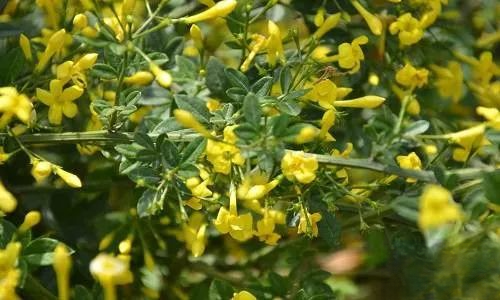Identification of 20 vine species
Learn plant design online (one-on-one guidance for small classes)
The course will start soon . Combined with project practice, you can study with a designer with more than 10 years of work experience in the evening. Register in advance to prepare for the course and get discounts.
Course consultation-WeChat:qljgsjwuming
Study consultation QQ: 3050229665
Lianas have always been a common plant material in gardening. Nowadays, the area available for gardening is getting smaller and smaller. Using climbing plants for vertical greening can expand green space and increase the amount of urban green. Lianas commonly used in vertical greening, some use suckers or tendrils to climb up, some hang down and cover the ground, and use long branches and vines, beautiful branches and leaves and flowers to form a landscape. Many lianas can be used to appreciate flowers in addition to leaves, and some lianas also emit fragrance. The roots, stems, leaves, flowers, fruits, etc. of some lianas can also provide medicinal materials, spices, etc.
According to the vertical greening methods of lianas in gardens, we recognize the soft beauty of various vines from three types: trellis greening, wall (railing) greening, and steep rock greening.
1. Pergola greening
1. Wisteria
Wisteria sinensis is a genus of Wisteria in the Fabaceae family. Wisteria sinensis, also known as Wisteria sinensis and Red Wisteria, is an excellent ornamental vine plant. It is generally used in garden trellises. In spring, the purple flowers are in full bloom, which is very interesting.
Identify with me: 1. The racemes grow on annual branches and droop.
2. The corolla is purple, the standard petal is round, the tip is slightly concave, and it folds back after the flower blooms.
3. There are 3 to 6 pairs of leaflets, which are papery and ovate.
Flower viewing period: April in spring
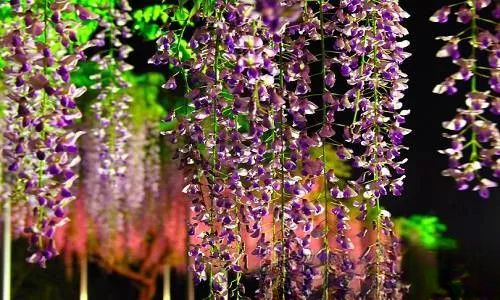
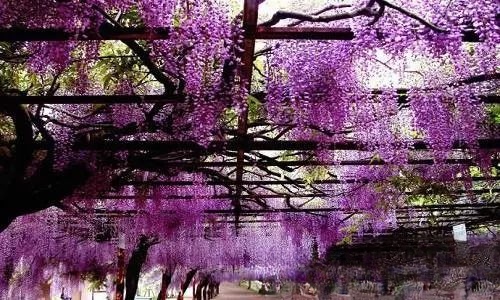
2. Double-petaled costus
Rosa banksiae, Rosaceae, genus Rosa. In spring, the slender branches of Rosa banksiae are attached to the leaves, stretching and embracing each other, cluster by cluster, forming a whole. Although the flowers are not large, they bloom all over the sky, harmoniously interweaving with the branches and jade leaves, like a silent poem and a three-dimensional painting.
Identify with me: 1. The flowers are small, and many are in umbels.
2. The petals are double to semi-double, white or yellow.
3. The petioles and rachises have sparse soft hairs and scattered small prickles.
Flower viewing period: Spring, April
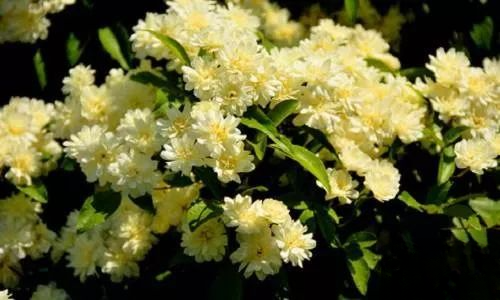
3. Bougainvillea
Bougainvillea spectabilis is a genus of Bougainvillea in the family Mirabilis. Other names include bougainvillea, three-leaf plum, bougainvillea, triangle flower, bougainvillea, etc. It is an evergreen climbing vine.
Identify with me: 1. The flowers are in the three bracts at the end of the branch, the pedicels are attached to the midrib of the bracts, and each bract has one flower.
2. The bracts are leaf-shaped, purple or magenta.
3. The leaves are papery, ovate, and have axillary thorns.
Flower viewing period: The flowers bloom between winter and spring (Guangzhou, Hainan, Kunming), and the northern greenhouse cultivation blooms from March to July.
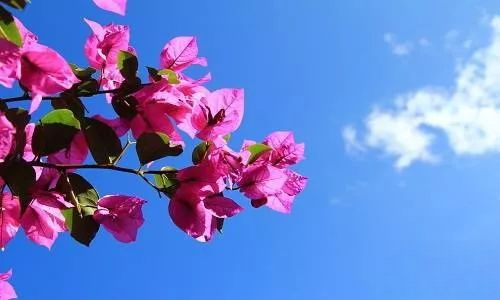
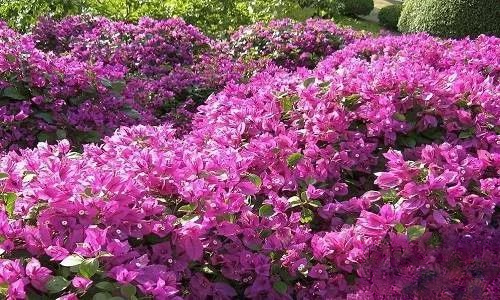
4. Fujimoto Tsuki
Climbing rose (Morden cvs. of Chlimbers and Ramblers) Rosaceae, Rosa genus. Other names: climbing rose, climbing rose. The stems of climbing roses are soft and slender, vine-like or vine-like, and have no climbing organs. They need to be artificially scaffolded or tied to pull them upward.
Identify with me: 1. Flowers grow solitary, in clusters or in clusters, with various colors and a long flowering period.
2. Odd-pinnate compound leaves, with 5 to 9 leaflets, small and thin, and stipules attached to the petiole.
Flower viewing period: The main flowering period is in summer, and it can also bloom in spring and autumn.
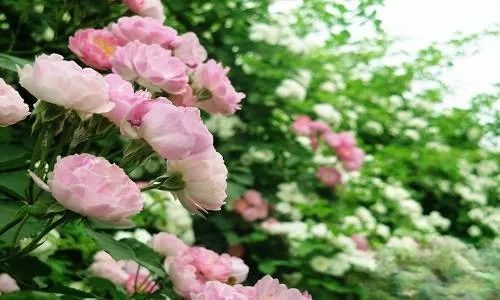
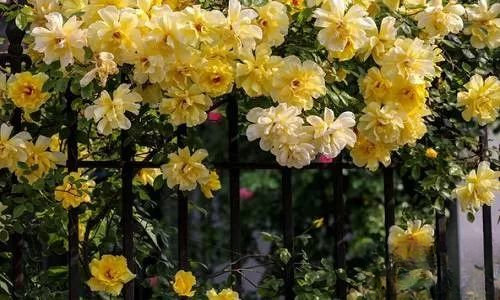
5. Yunshi
Caesalpinia mimosoides is a genus of Caesalpinia in the Fabaceae family. It has been used in gardens in recent years. Its flowers are small and beautiful with yellow flowers.
Identify with me: 1. 5 petals, bright yellow, nearly round, 4 of which are larger.
2. Branchlets are densely covered with rusty glandular hairs and barbed spines, with bipinnate leaves.
Flowering period: Flowering period is from November to December, and it can also bloom in spring.
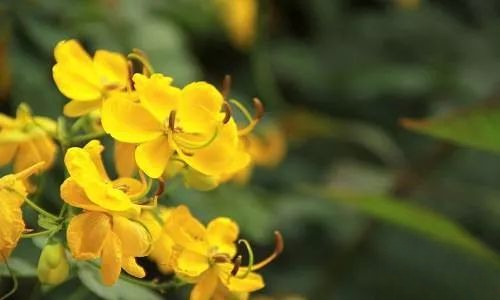
6. Akebia trifoliata
Akebia trifoliata, Akebia family, Akebia genus. Commonly known as September fried melon, August melon. The original species mostly grows in sparse forests beside mountain valleys or hilly shrubs, and the fruit is peculiar in shape.
Identify with me: 1. The raceme emerges from the clustered leaves on the short branches, with 1-2 female flowers at the bottom.
2. The fruit is oblong, large, straight or slightly curved, and grayish white with a slight lavender color when ripe.
3. There are 3 leaflets, papery or thin leathery.
Flower viewing period: flowering period is April-May, fruiting period is July-August.
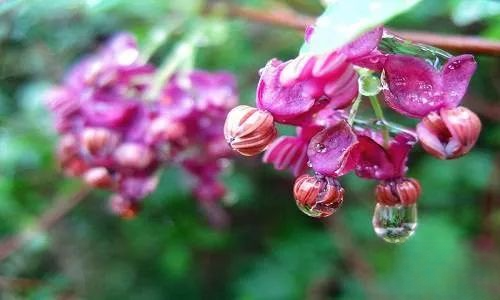
7. Quisqualis
Quisqualis indica, Combretaceae, genus Quisqualis. Other names: Liuqiuzi, Shijunzi, Wushuzi, Suoziguo, etc.
Identify with me: 1. Terminal spike inflorescence, forming a corymbose inflorescence, bracts linear lanceolate.
2. Leaves are opposite or nearly opposite, membranous, densely covered with rusty soft hairs when young.
Flower viewing period: flowering period in early summer, fruiting period in late autumn.

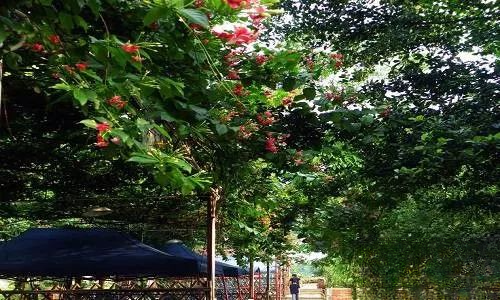
8. Passionfruit
Passiflora coerulea, Passifloraceae, Passiflora genus. Other names: Passion fruit, Passion fruit, Brazil nut, Passion fruit, Vine peach, Passion fruit, etc.
Identify with me: 1. Cymes are degenerate with only one flower, opposite to the tendril, and the flower is large.
2. Berries are ovoid to nearly spherical, orange-yellow or yellow when ripe.
3. Leaves are papery, heart-shaped at the base, and palmately 5-lobed.
Flower viewing period: Flowering period is May-July.
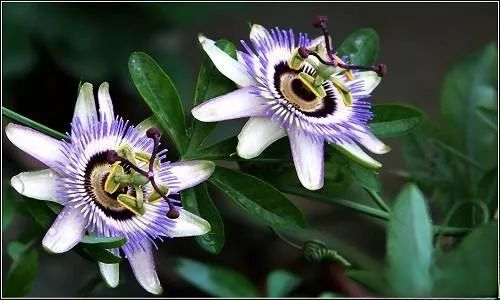
2. Wall (railing) greening
1. Clematis grandiflora
Clematis patens, Ranunculaceae, Clematis genus. Other names: rotor clematis, wheel clematis.
Identification: 1. Single flower terminal; pedicel straight and strong, without bracts, large flower.
2. Leaflets usually 3, rarely 5, papery, oval or ovate-lanceolate.
Flower viewing period: Flowering period from May to June, fruiting period from June to July.
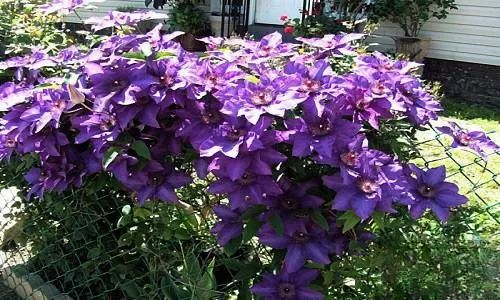
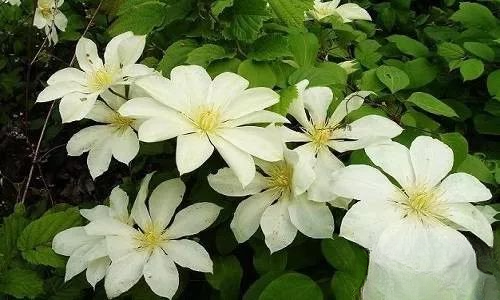
2. Firecracker Flower
Pyrostegia venusta, Bignoniaceae, Pyrostegia genus. Other names: firecracker flower, eel vine. Pyrostegia venusta blooms warmly and is a good flower stand plant and wall greening plant.
Identify with me: 1. The corolla is tubular, contracted at the base, orange-red, with 5 lobes, oblong.
2. The filaments are filiform, the anthers are forked, and the style and filaments extend out of the corolla tube.
3. It is a vine with 3-pronged filiform tendrils, opposite leaves, and 2-3 leaflets.
Flower viewing period: The flowering period is long, which can last up to half a year in Xishuangbanna Tropical Botanical Garden, Yunnan, usually from January to June.
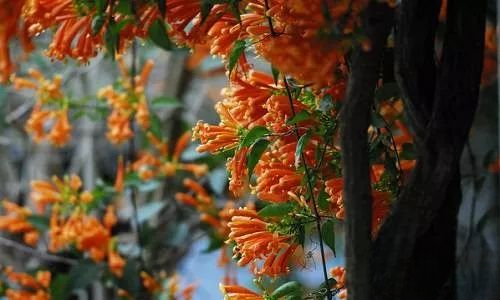
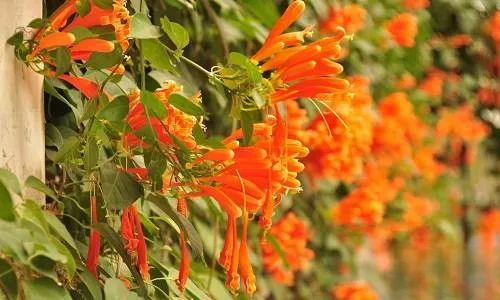
3. American trumpet creeper
Campsis radicans is a deciduous woody vine of the Bignoniaceae family, with sparse and uneven shadows, lush green leaves, and star-shaped flowers, which are brilliant and vibrant. It is often used in gardens, courtyards, stone walls, walls, rockeries, under dead trees, flower corridors, trellises, flower gates, etc.
Follow me to identify: 1. The cymes are borne on the top of the branches, the inflorescence is lush and dense, the calyx is shallowly lobed, the corolla is slender and funnel-shaped, and the tube is very long, 3 times the length of the calyx. The flower tube is orange-red, and the lobes and edges are bright red.
2. The odd-pinnate compound leaves are opposite, and the leaflets are elliptical.
Flower viewing period: The natural flowering period is concentrated in two stages: May to June and September to October.
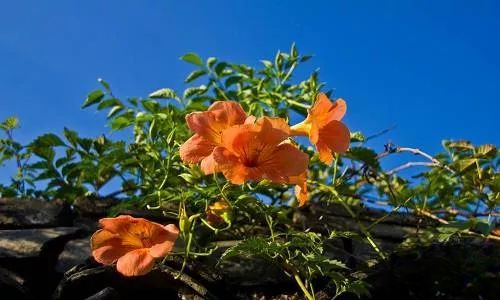
4. Featherleaf morning glory
Quamoclit pinnata, Convolvulaceae, Quamoclit genus. Other names: Wandering dragon grass, Brocade screen seal, Dragon flower.
Identification with me: 1. Cymes are axillary, flowers are small, corolla is high-footed saucer-shaped, deep red, and looks like a five-pointed star.
2. Leaves are deeply pinnate, with linear lobes; 2 stipules, the same shape as the leaves.
Flower viewing period: Flowering period from August to frost, fruit ripening period from September to November.
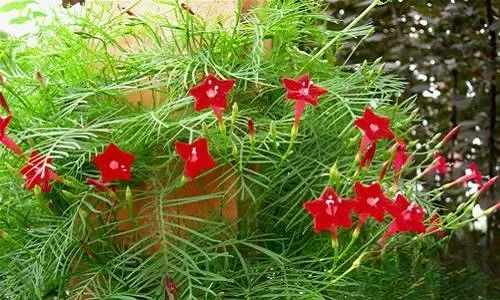
5. Ivy
Ivy (Hedera nepalensis) belongs to the Araliaceae family and belongs to the genus Hedera. Other names include earth drum vine, sky-piercing wind, triangular wind, scattered bone wind, and maple pear vine. Ivy has beautiful leaves and is evergreen all year round. It is often used for vertical greening in various parts of the south. It is often planted beside rockery and at the base of walls, allowing it to grow vertically or cover naturally, which has the effect of decorating and beautifying the environment. When potted, small and medium-sized pots are mainly used, and various shapes can be made.
Identify with me: 1. The umbel inflorescence is single and terminal, the flowers are light yellow-white or light green-white, and the anthers are purple. 2. The leaves are dimorphic, the leaves on ordinary branches are triangular-ovate or halberd-shaped, with entire or three-lobed edges; the leaves on the flower branches are elliptical-lanceolate.
Flower viewing period: flowering period from September to November, fruiting period from March to May of the following year.
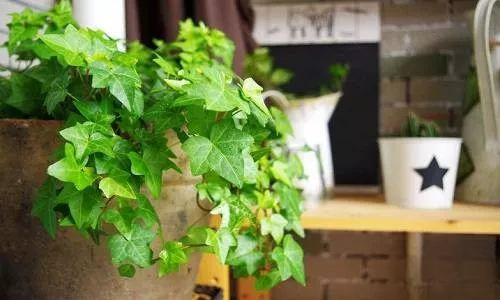
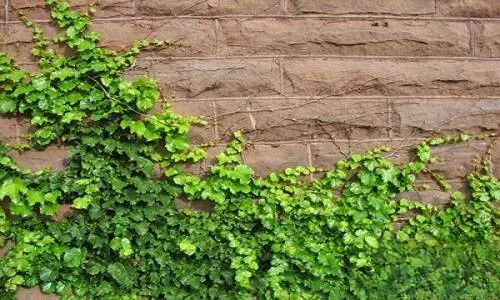
6. Ficus pumila
Ficus pumila, Moraceae, Ficus genus. Other names: Liangfenzi, Magnolia, Liangfenguo, etc.
Identification with me: 1. Leaves are of two types, adventitious roots grow on fruitless branches, and leaves are ovate-heart-shaped.
2. Figs grow solitary in leaf axils, gall fruits are pear-shaped, and female fruits are nearly spherical.
Flowering and fruiting period: Flowering and fruiting period is May-August.
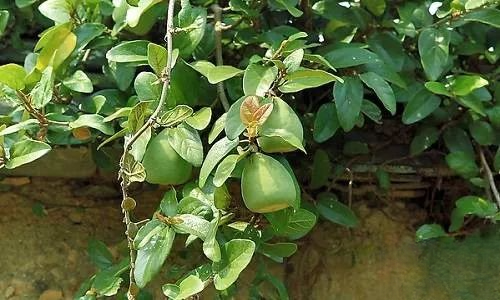
7. Morning Glory
Morning glory (Ipomoea nil) is a Convolvulaceae plant. Other names include morning glory, trumpet flower, tendon horn puller, big morning glory, diligent lady, etc. The flowers are bright and beautiful, and the flower shape is beautiful. It is used as a climbing plant for railings for viewing.
Identification with me: 1. Cymes are axillary, with 1 to several flowers. The corolla is trumpet-shaped. The flowers are bright and beautiful.
2. The creeping stems are slender, about 3 to 4 meters, and the whole plant is densely covered with short bristles.
3. The leaves are alternate, entire or lobed.
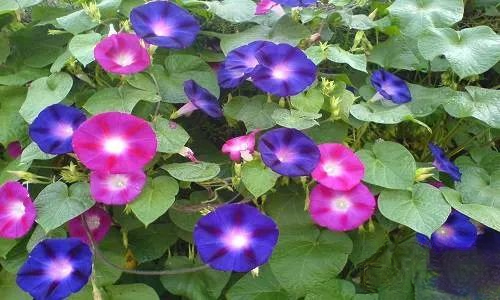
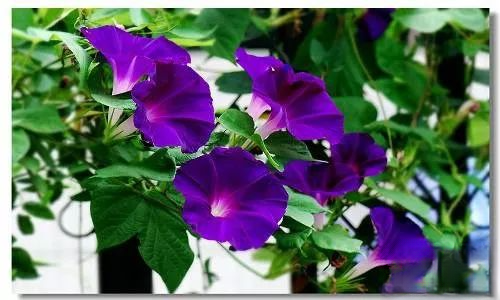
8. Ivy
Parthenocissus tricuspidata is a member of the genus Parthenocissus, in the family Vitaceae. Other names include creeper, ground ivy, flying centipede, false grapevine, etc. Parthenocissus tricuspidata is the most commonly used and ideal climbing plant. It relies on suction cups to climb up the wall. After a long time of planting, dense green leaves cover the exterior walls of the building, just like wearing green clothes. In spring, Parthenocissus tricuspidata grows lushly; in summer, it blooms small yellow-green flowers; in autumn, the leaves of Parthenocissus tricuspidata turn orange-yellow; this makes the color of the building rich in variety.
Identify with me: 1. Cymes, with petals reflexed at the top.
2. Leaves are alternate, leaflets are thick, with great variation, coarse serrations on the edges, and leaves and veins are symmetrical.
Flowering and fruiting period: Flowering period is June, and fruiting period is about September to October.
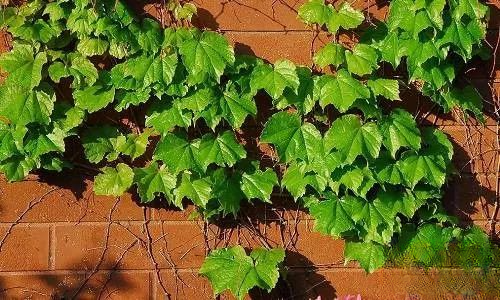

3. Steep Rock Greening
1. Honeysuckle
Honeysuckle (Lonicera japonica) belongs to the Caprifoliaceae family and the genus Lonicera. It blooms in March, with five petals and a slight fragrance. The pedicel is red. The flowers are white when they first open, and turn yellow after one or two days, hence the name honeysuckle. Because there are two flowers on one pedicel, and the two stamens are exposed, they are in pairs and inseparable, like a pair of mandarin ducks dancing, so it is also called the mandarin duck vine.
Identify with me: 1. The bracts are leaf-shaped, the lip-shaped flowers have a light fragrance, and there are soft hairs and glandular hairs on the outside.
2. The stamens and pistils extend out of the corolla, and the flowers grow in pairs in the leaf axils. The color of the flowers is white at first and gradually turns yellow.
3. The ovate leaves are opposite, and the branches and leaves are densely covered with soft hairs and glandular hairs.
Flower viewing period: The flowers bloom from late spring to late summer.
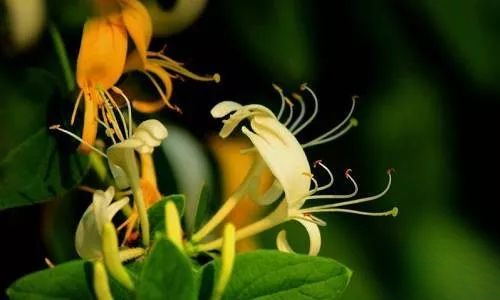
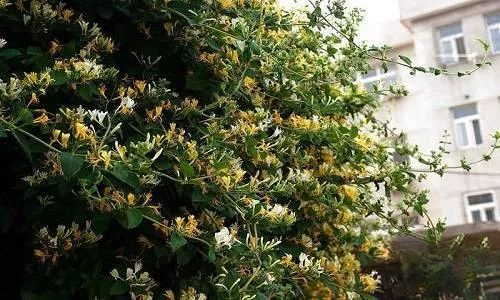
2. Trachelospermum jasminoides
Trachelospermum jasminoides, Apocynaceae, Trachelospermum genus. Other names: stone dragon vine, ten thousand word flower, ten thousand word jasmine. Trachelospermum is often used as ground cover in gardens, vertical greening of steep rocks or potted ornamental plants.
Identification with me: 1. The dichotomous cymes are axillary or terminal, and the flowers are many and form a cone shape. The flowers are white and fragrant.
2. The leaves are leathery, with a slightly concave midrib on the leaf surface, flat lateral veins, and a convex midrib on the back of the leaf.
Flowering and fruiting period: Flowering period March-July, fruiting period July-December.
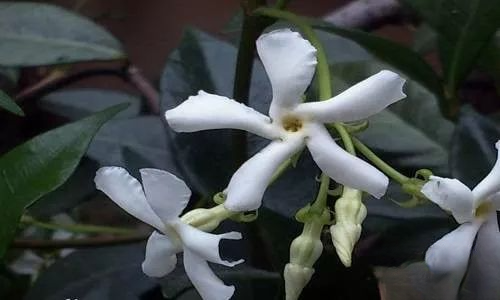
3. Celastrus orbiculatus
Celastrus orbiculatus Celastraceae, Celastrus genus. Other names: Golden Silver Willow, Golden Red Tree, Mountain Wind. This plant has a beautiful posture and high ornamental value. It is an excellent tree species for urban vertical greening.
Identify with me: 1. The petals are obovate or rectangular, the disc is shallowly cup-shaped, and the corolla of the female flower is narrower than that of the male flower. 2.
The capsule is nearly spherical, the seeds are oval and slightly flat, and reddish brown.
3. The leaves are usually broadly obovate, nearly round, and have serrated edges.
Flowering and fruiting period: flowering from May to June, fruiting from July to October.
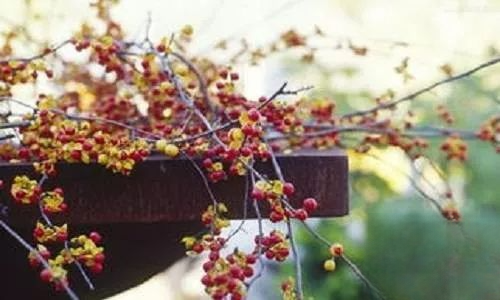
4. Yunnan Jasmine
Yunnan Yellow Jasminum (Jasminum mesnyi) Oleaceae, Jasminum genus. Other names: Wild Jasmine, Golden Belt. Jasminum mesnyi has long and weak branches, drooping or climbing, with green leaves and yellow flowers. It can be planted on embankments, terraces and the edges of steps. It is particularly suitable for hotel and building ceilings, and can also be potted for viewing.
Identify with me: 1. The corolla is yellow, funnel-shaped, with 6-8 lobes.
2. The leaves are opposite, trifoliate, and the leaves are nearly leathery, almost hairless on both sides, with curled leaf margins and eyelashes.
3. The twigs are quadrangular, grooved, smooth and hairless.
Flower viewing period: Flowering period from November to August of the following year, fruiting period from March to May.
